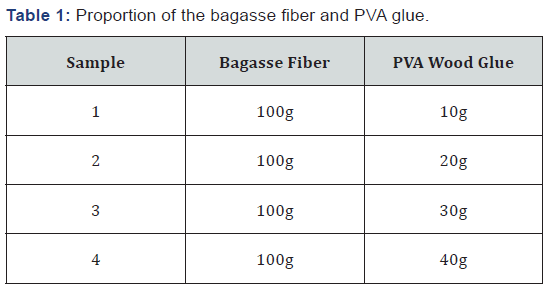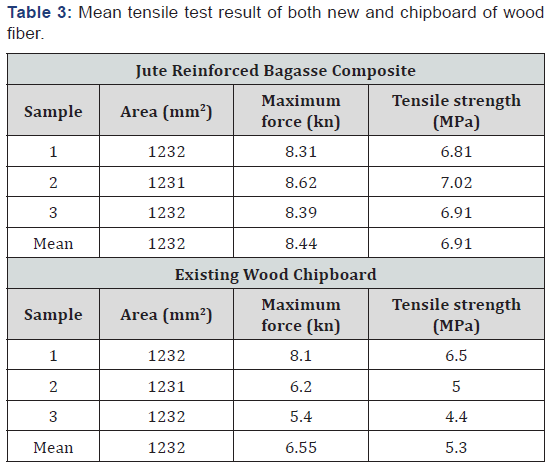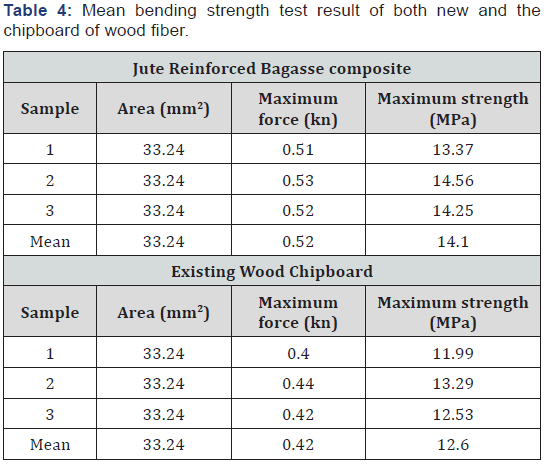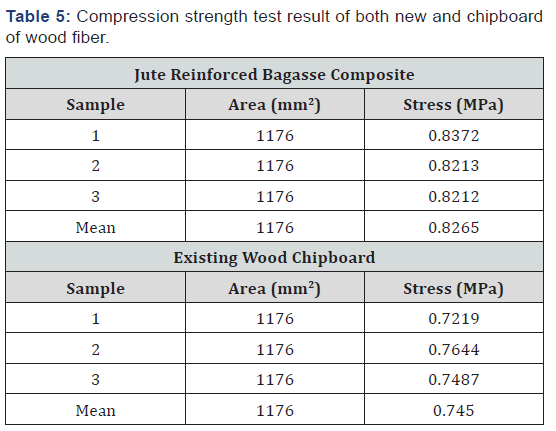Manufacturing and Characterization of Hybrid Composites with Natural Fibers
CURRENT
TRENDS IN FASHION TECHNOLOGY & TEXTILE ENGINEERING-
JUNIPER
PUBLISHERS
Abstract
In the present investigation an attempt has been made to fabricate jute reinforced bagasse composites which was developed by layer by layer techniques of composite manufacturing methods. As it was known, previously ceramics and plastics materials have been more dominant in the world market. Due to the rapid growth of the applications of composite materials, they penetrate and conquer the new markets persistently. Nowadays, composites have become one of the most important engineering materials in various applications. This composite material has been made by using sugarcane bagasse as a filler, jute natural fiber as reinforcement material with PVA as matrix. The fabricated composite materials were characterized for its mechanical properties like tensile, bending and compression strength and compared with the existing wood chipboard. The test result obtained showed that the jute reinforced sugarcane bagasse composite has higher strength in tensile, compression and bending properties than the existing wood fiber chipboard. From this research work it was drawn that using natural fibers as a reinforcing and as filler materials for manufacturing of composites materials provided good mechanical properties and becomes the recent research area and have various applications in volume and numbers.
Keywords: Waste sugarcane bagasse; Jute fiber; Biocomposites; Mechanical properties; Characterization; Natural fibers; Engineering materials
Introduction
Nowadays, composites have become one of the most important engineering materials in various applications [1]. Composites are materials which consist of two or more distinct constituents or phases which can be combined to produce a material with entirely different properties from the individual constituents [2]. The demands for composites are gradually increasing as composites are more preferred compared to other materials such as metals and ceramics. The main reason for this is because composites are relatively cheaper and have high availability. Ahead of that, the properties of composites can be altered according to the desired applications [1]. However, the trend of the world today leans toward biodegradable or “green” materials which are more environmental friendly. These “green” materials are also sustainable as it comes from renewable resources. Even though composites have many uses in the industry, it is a better idea to apply “green” composite or biocomposite [3]. Biocomposites are a type of composite where either one or both constituent materials; matrix and reinforcement are of biological origin [1,4]. As mentioned before, at least one of the constituent materials of the bio-composite must be of biological origin. In this investigation, bagasse fibers were used as the filler material with jute and PVA for the biocomposite.
The creation of bio-composite fibre board can be also used in wall construction and is potentially to contribute of making cost effective home possible [5]. The reinforcement of a composite is a discontinuous material usually in the form of fibrous or particulate. As the name ‘reinforcement’ implies, this fibrous/particulate material is used to reinforce and enhance the properties of the composite. It can be said these reinforcement materials are the backbones of composites as they are the principle load carrying agent. This material has better properties or stronger than the matrix material. However, the reinforcement fibers or particles require the matrix substance to hold it and to spread out the load uniformly [1,6]. Fillers not only reduce the cost of composites, but also frequently impart performance improvements that might not otherwise be achieved by the reinforcement and resin ingredients alone. Fillers are often referred to as extenders. Fillers can improve mechanical properties including fire and smoke performance by reducing organic content in composite laminates [4]. Among the plant origin fibers jute and sisal are the most widely used because of their availability and strength [7]. Therefore, jute fiber is used in this research work as a reinforcing material. In recent years, there has been an increasing movement toward more efficient utilization of residual agro-industrial products such as sugarcane bagasse and jute fiber [4,8]. The biodegradability of the natural fibers is considered as the most important and interesting aspects of their utilization in polymeric materials [9]. Such natural fibers are low-cost fibers with high specific properties, low density, and eco-friendly.
It will be an alternative way to develop the biocomposites which can be particularly used for daily needs of common people whether it is household furniture, house, fencing, decking, flooring, and light weight car components or sports equipment [4,10]. Jute fibre is 100% bio-degradable and recyclable and thus environmentally friendly. Jute is a bast fiber used for sacking, burlap, and twine as a backing material for tufted carpets. It is a long, soft, shiny fiber that can be spun into coarse, strong threads. It is one of the cheapest natural fibers and is second only to cotton in amount produced and variety of uses [11- 13]. Bagasse is the residue fiber remaining when sugar cane is pressed to extract the sugar. Bagasse is composed of fiber and pith, the fiber is thick walled, coarse, stiff and relatively long. Bagasse is a plentiful lignocellulosic waste typically found in tropical countries that process sugarcane. It is used either as a fuel for boilers by the sugar factory or as a raw material for the manufacture of pulp and paper products. Currently, bagasse sugarcane, a waste product of the sugar industry, is mainly burned as fuel in sugar mill boilers. The low cost, low density and acceptable mechanical properties of bagasse fiber make it an ideal candidate to be considered for value-added applications such as filler in jute reinforced composites [2,14]. The main objective of the study is to evaluate the mechanical properties and characterization of jute reinforced bagasse composite. It will be an alternative way to develop the biocomposites which can be particularly used for daily needs of common people. Their low cost, easy availability and aesthetic designs will be the main driving force to transform the depended present to sustainable future. Significant research is currently underway around the world to address and overcome the obstacles mentioned above. This effort to develop biocomposite materials with improved performance for global applications is an ongoing process.
Materials and Methods
Materials
The materials used in this study to fabricate the jute reinforced bagasse composites were waste sugarcane bagasse, jute fiber, PVA glue, mold with presser, timbers, and plastics. For the characterization of the mechanical properties of the composite materials the following equipment’s were required such as universal strength tester, box compression tester and 3-point bending tester
Preparation of the samples
To fabricate the composites, first the bagasse was collected from the nearby area and then washed thoroughly in order to remove sugar. After proper washing of the bagasse, it was dried nearly a day to remove any moisture present in it. The bagasse was treated with alkali solution to kill bacteria present in it. The alkali treated bagasse crashed into small fibers by using cutter. On the other hand, the reinforcing jute fibers were purchased from the market.
Manufacturing methods of the composite
Hand layup is the most basic fabrication methods for composites which typically consist of laying dry fabric layers, or “plies,” or prepreg plies, by hand onto a tool to form a laminate stack. Resin is applied to the dry plies after layup is complete (e.g., by means of resin infusion). In a variation known as wet layup, each ply is coated with resin and “debulked” or compacted after it is placed [15].
Design of the jute reinforced bagasse composite
A composite is fabricated combining jute a natural fiber with a polymer resin a matrix through layer by layer method at a suitable temperature for bonding of the materials and curing process to take place. The fabricated specimen composite was tested for its mechanical properties using conventional testing machines and the values recorded. The recorded results are compared with the chip board of wood fiber. The results obtained were analyzed and discussed to identify its properties and find suitable applications. Chipboard were made by bonding together wood particles with an adhesive under heat and pressure to form a rigid board with a relatively smooth surface. In this study the same process was taken and the filler material (wood particles) replaced by sugarcane bagasse.
Proportion of the reinforcing, matrix and filler materials
After determining of the sample which achieved the best strength depending on the mixing proportions, the entire samples were fabricated as per the optimized conditions and compared with the chipboard of wood fiber (Table 1).

Processes to manufacture the composite
Sugarcane bagasse were collected and crashed to small particles which are suitable for the process. These the crashed bagasse chips were glued with resins. Spreading out of the mixture on the plate and placing the reinforcement material on the mixture with different orientation. Then cover the edge of the plate and press with heated presses. Finally finishing and cutting of the produced board as per the requirement and then conduct test to characterize the products (Figure 1).

Testing of the composite
The manufactured composite materials mechanical properties were characterized and compared with the wood chipboard. The tensile strength was measured by using universal strength tester according to ASTM D3039 standard. Compression strength test were done by box compression testers according to ASTM E209 standard. Bending strength test was measured by 3-point bending test according to ASTM D790 standard
Result and Discussion
Testing of the tensile, compressive, and bending strength of both the jute reinforced bagasse composite and the existing wood fiber chipboard were made according to ASTM standard and the result compared (Table 2).

Tensile strength analysis
All tensile strength tests were conducted as per ASTM in 100kN servo electronic universal testing machine. A significant difference was observed from the stress-time behavior due to addition of different weight percentage of bagasse and jute fibers. The results of both jute reinforced bagasse composite and existing wood chipboard was presented in (Tables 3). The above Table 3 and Figure 2 test results showed that there was a remarkable difference in the ultimate tensile strength of both the new jute reinforced bagasse composite material and the existing wood chipboard material. The new jute reinforced bagasse composite material has a mean tensile strength value of 6.91 which is higher than the existing chipboard which has a mean tensile strength value of 5.3. The increase of ultimate strength of the new product is due to using of both bagasse and jute fibers instead of wood chip. However, significant increase in modulus of elasticity is seen due to the presence of bagasse content in the material. Without bagasse fiber the increase in modulus of elasticity is less, but only bagasse fiber improves the modulus elasticity property. The percentage elongation of material also increases with the presence of the fiber.


Bending strength analysis
All bending strength tests was conducted as per ASTM in 100 kN servo electronic universal testing machine. A significant difference was observed in the stress-time behavior due to addition of different weight percentage (wt.%) of bagasse and jute fibers. The results of both jute reinforced bagasse composite and existing chipboard of wood fiber was presented in (Table 4). From the above Table 4 test result it was observed that both samples have different bending strength with the same crosssectional area. This investigation showed that the mean bending strength value of the jute reinforced –bagasse fiber composite is found to be 14.1 MPa. This value is higher than and the existing chipboard of wood fiber which is 12.6. Hence, it can be concluded that proper combination of the bagasse and jute fiber hybrid composite material may have a variety of application when weight and strength would be the critical parameter in the design.

Compression strength analysis
The compressive strength of both jute reinforced bagasse fiber hybrid composite materials was determined by 100 kN load using compression testing machine at 1 mm/min cross head speed under displacement control mode. The compression strength test result of the jute reinforced bagasse composite and the chipboard of wood fiber was presented in the (Table 5). From the above Table 5 test result, it was shown that the jute reinforced bagasse composite material has a mean stress value of 0.8265 which is higher than the existing wood fiber chipboard which has a mean tensile strength value of 0.745. This tells as rigidity and compressive strength of the jute reinforced composite are higher compared to that of the chipboard of wood fiber. Jute reinforced bagasse composite can resist higher amount of stress than the existing product i.e. the new jute reinforced bagasse product has higher compressive strength value than the chipboard of wood fiber. This is because of the presence of jute fiber as reinforcement.

Conclusion
In this research work an attempt was made to fabricate a composite material which is made from jute reinforced bagasse composite and compared with the chipboard of wood fiber. From the above discussion it was concluded that the tensile, bending and compression strength of the new manufactured jute reinforced bagasse composite was better than the chipboard of wood fiber. This result shows that the manufactured composite materials have the tendency to replace the chipboard of wood fiber in the market in various applications. Natural fibers and composites made from natural sources integrate the sustainable, eco-friendly and well-designed industrial products which can replace dominance of synthetic based products in future. Interfacial adhesion between natural fibers and matrix will remain the key issue in terms of overall performance, since it dictates the final properties of the composites. The utilization of bagasse fibers for fabrication of biocomposites by using advance technology transforms future of coming generation. Bagasse fiber is obtained from a source which is known for its renewability in terms of fast growth and better mechanical properties. The well designed and engineered products from the bagasse fibers can help in making new revolution to sustain our natural resources. Thereby, based on this background information the bagasse fibers can be utilized for advance and engineered product development for different applications
It will be an alternative way to develop the such composites which can be particularly used for daily needs of common people whether it is household furniture, house, fencing, decking, flooring, and light weight car components or sports equipment’s. Their low cost, easy availability and aesthetic designs will be the main driving force to transform the depended present to sustainable future.
To Know More About Current Trends in Fashion
Technology & Textile Engineering Please click on:
https://juniperpublishers.com/ctftte/index.php
To Know More About Open Access
Journals Please click on: https://juniperpublishers.com/index.php




Comments
Post a Comment